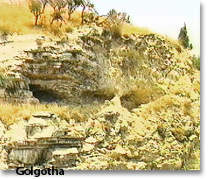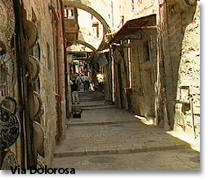HOLY WEEK
Good Friday: The Death and Burial of
Jesus Christ
By Laura J. Bagby
CBN.com Producer
CBN.com
- "For
God so loved the world that he gave his one and only Son, that whoever
believes in him shall not perish but have eternal life"
Imagine what disillusionment, confusion, and anguish the followers
of Jesus Christ felt the day their Lord and Savior died. Not
only were they experiencing the loss of a dear friend, but for
a time, they too experienced a loss in their faith. God seemed
to be so silent. Why was this happening? Was Jesus really God?
Faith was being shaken.
Now imagine being the Son of God, all-powerful and totally capable
of getting off that cross. Jesus could have easily decided to rewind
the tape, edit the story, freeze the crowd, and disappear. But He did
not because He knew He was on a mission from God to save the world from
their sins and bring freedom to men and women cursed by the Fall.
 He decided to take the sins of the world
on His shoulders so that we might gain forgiveness for our sins
and a new and righteous relationship with the One True God through
Jesus Christ our Savior. He decided to take the sins of the world
on His shoulders so that we might gain forgiveness for our sins
and a new and righteous relationship with the One True God through
Jesus Christ our Savior.
Jesus was so in tune with God that despite His divine power and authority,
He submitted His very life to God the Father. The death of Jesus Christ
was the ultimate in humility, the ultimate in love, the ultimate in
doing what was right no matter what the cost.
Jesus Dies to
Fulfill Prophesy
Many years before the coming of Jesus Christ, the prophet Isaiah gives
an incredibly rich and accurate description of Christ's eventual death.
He not only includes the ways in which Jesus would suffer, but why he
had to suffer.
Beginning in Isaiah 53: 5, the prophet writes:
But he was pierced for our transgressions, he was crushed
for our iniquities; the punishment that brought us peace was upon
him, and by his wounds we are healed. We all, like sheep, have gone
astray, each of us has turned to his own way; and the Lord has laid
on him the iniquity of us all. He was oppressed and afflicted, yet
he did not open his mouth; he was led like a lamb to the slaughter,
and as a sheep before her shearers is silent, so he did not open his
mouth. By oppression and judgement he was taken away. And who can
speak of his descendants? For he was cut off from the land of the
living; for the transgression of my people he was stricken. He was
assigned a grave with the wicked, and with the rich in his death,
though he had done no violence, nor was any deceit in his mouth. Yet
it was the Lord's will to crush him and cause him to suffer, and though
the Lord makes his life a guilt offering, he will see his offspring
and prolong his days, and the will of the Lord will prosper in his
hand. After the suffering of his soul, he will see the light of life
and be satisfied; by his knowledge my righteous servant will justify
many, and he will bear their iniquities. Therefore I will give him
a portion among the great, and he will divide the spoils with the
strong, because he poured out his life unto death, and was numbered
with the transgressors. For he bore the sin of many, and made intercession
for the transgressors" (Isaiah 53:5-12, NIV).
Also in the New Testament, Jesus foretells His own death:
"The reason my Father loves me is that I lay down my
life -- only to take it up again. No one takes it from me, but I lay
it down of my own accord. I have authority to lay it down and authority
to take it up again. This command I received from my Father" (John
10:17-18, NIV).
The Via Dolorosa
 The Via Dolorosa, meaning "the way of
the cross, the way of suffering," was the street in Jerusalem where
Jesus bore the cross from the city on the way to Golgotha. After standing
before Caiaphas, the high priest, Jesus was then delivered into the
hands of Pilate for His death sentence. He was whipped and a crown of
thorns was placed upon His head. Then He was made to carry the crossbeam
through this narrow street. The actual street on which Jesus walked
is proposed to be anywhere from eight to fourteen feet below the current
cobblestone street of today. The Via Dolorosa, meaning "the way of
the cross, the way of suffering," was the street in Jerusalem where
Jesus bore the cross from the city on the way to Golgotha. After standing
before Caiaphas, the high priest, Jesus was then delivered into the
hands of Pilate for His death sentence. He was whipped and a crown of
thorns was placed upon His head. Then He was made to carry the crossbeam
through this narrow street. The actual street on which Jesus walked
is proposed to be anywhere from eight to fourteen feet below the current
cobblestone street of today.
Golgotha
This is the place where Jesus was crucified. In the side of this overlook
is what looks like a skull etched by nature into the soft stone of this
hill; thus, we often refer to this site as the "Place of the Skull"
(see Luke 23:33).
Crucifixion
The Romans did not invent death by crucifixion; the Palestinians invented
it as a punishment reserved for either runaway slaves or the worst criminals
of the state.
Before bearing the cross, the prisoner was beaten with a metal-tipped
whip. Then he was expected to carry the crossbeam through the streets
to the site of his eventual death. The upright section of the cross
was already in the ground.
Both hands and feet were nailed to the cross, and above each cross
was an inscription of the prisoner's name and crime committed.
Death by crucifixion was slow and extremely painful. Sometimes it could
take as long as two days before the criminal died. Ultimately, death
was caused by asphyxiation.
The Biblical Accounts
of the Death and Burial of Jesus
Matthew 27:11-66; Mark 15:1-47; Luke 23:1-56; John 18:28-19:42
More from CBN.com's special Easter
section
Answers to your questions about Jesus from 'The Passion of The Christ'
CBN IS HERE FOR YOU!
Are you seeking answers in life? Are you hurting?
Are you facing a difficult situation?
A caring friend will be there to pray with you in your time of need.
|